by V.N. Muthukumar and M.V. Ramana
First published on SAWF on November 4, 2002
M. V. Ramana is currently at the Program on Science and Global Security, Princeton University.

M.V. Ramana
In this article, we discuss the raga Natakurinji.
Natakurinji is a relatively recent raga. There is no reference to this raga in pre-18th century literature [1]. The name of the raga suggests that the origins of this raga are in the music of the early Tamils. But, there is not much evidence in support of this hypothesis. Some scholars assign kurinjippan to the contemporary scale Harikambodi [2]. Indeed, Natakurinji does fit in as a janya raga of the Harikambodi mela. However, there appears to be no pan equivalent of Natakurinji in vogue. Musicological works like the Sangita Makarandam (ca. 7th century CE) and the Caturdandi Prakasika (ca. 17th century CE) contain no references to Natakurinji. According to Prof. Janakiraman, Tulaja’s Sangita Saramrta (ca. 1735 CE) refers to this raga. Natakurinji is also described in Govinda’s Sangraha Coodamani (ca. 19th century CE). The descriptions of Natakurinji in these two treatises coincide approximately with the raga’s current form.

Karaikuruchi Arunachalam
It is interesting to note that quite a few Tamil lyrics associate the name Natakurinji with natyam (dance), the most popular being kavalaiyai teerpatu natiya kalaiye. Composed by Papanasam Sivan, this song appeared in the movie Sivakavi (music director: G. Ramanathan). The singer was the rage of the day, M. K. Tyagaraja Bhagavatar [3].
Natakurinji is a rakti raga. It can be sung at all times; the raga can be elaborated in both slow and medium tempos. It is a popular choice for ragam, tanam and pallavi, and is especially well suited for elaboration by tanam. Natakurinji is an example of a raga whose scope has been defined by kalpana rather than kalpita, viz., kritis.
The raga uses the following notes – r2 (ri) g3 (gu) m1 p d2 (di) n2 (ni).
Since there is no ambiguity, we shall use lower case letters for all swaras in this article. An underscore indicates lower octave and double quotes indicate higher octave.
Natakurinji illustrates the inadequacies of “defining” a raga by an arohanam-avarohanam and/or its parent melakartha or scale. For instance, Govinda’s Sangraha Coodamani lists Natakurinji as a janya of the 28th mela Harikambodi and offers the following arohana/avarohana:
s r g m d n s” s” n d m g s.
M. K. Tyagaraja Bhagavatar
However, in practice, one seldom hears this straight arohana. The lakshana of this raga can be seen in the famous varnam calamela composed by Moolavattam Rangasami Nattuvanar. In the following clip, we hear the veteran flautist K. S. Gopalakrishnan play this varnam. T. N. Krishnan plays the violin and T. K. Murthy, the mridangam. The recording is from a live concert at Shanmukhananda Hall (Bombay, 1974).
As can be inferred from the above recording, a description based on arohana-avarohana does no justice to this raga. It is for this reason that Muthu Venkatamakhi while describing Natakurinji says, “. geeyate lakshya vedibhi“. Subbarama Dikshitar translates this line as “.the arohana avarohana murchana of this raga is given by s r g m p d n s” s” n d m g s… But as mentioned in the above sloka, the form of this raga is to be understood from the prayogas that occur in geeta and kriti and sung accordingly…” [4]
Illustrating our comment that Natakurinji is often associated with dance, we offer a varnam in Natakurinji, sami nan untan adimai. It is a popular number in dance recitals and was composed by Papanasam Sivan [5]. The lyric describes the devotee pining for her Lord (Siva, the Lord of Dance). The singer is Rukmini Ramani, the composer’s daughter.
The same varnam sung by M. L. Vasantakumari, for a dance recital. Charumati Ramachandran provides vocal support.
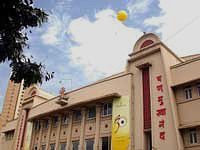
Shanmukhananda Hall, Bombay
All the swaras in this raga except r are jeeva swaras and can be used suitably as nyasa swaras. Though r is not used as a nyasa swara, it occurs frequently and almost invariably in conjunction with s. Some examples are d_ n_ s (r) s, d_ n_ s r n_ s and g m p g r s. In prayogas such as s r s and n_ s r s, the rishaba is often articulated at the gandhara. The swara m divides the poorva and uttara angas of the raga. This swara occurs in both forms, unshaken and as m (g) m. Some typical poorvanga prayogas are given below:
m g s
r g m g s
s m (g) m
s (r) g m
d_ n_ s (r) s g (g) m
g m (p) g r s g g m
The dhaivata is a strong note in the uttaranga as can be seen in prayogas such as g m n d, m g m n d. Consequently, the nishada is often oscillated in the arohana krama as (d) n and (d) n d n s”. A glide from a strong d to m is very appealing.
The panchama has a special place in this raga. As Prof. Janakiraman points out, “.. it is not within raga dharma to avoid the panchama in the elaboration of Natakurinji” [6].
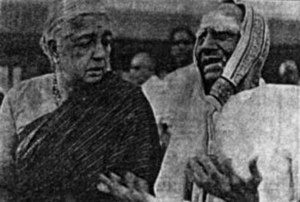
Papanasam Sivan and Rukmini Arundale
This note usually appears in the arohana and avorahana kramas as n d n p d n s” and g m p g r s respectively. The phrase m g r s is heard sometimes, but we opine that it is avoidable. The recordings adduced in this feature will show that even the phrase g m g r s only appears as g m (p) g r s. The phrase s” d p m g m p g r s is seen in lakshya.
Some common uttaranga prayogas are
m g m n (d) n
m g m n d n p d n
d n s” d n p d n
The tara stayi shadjamam is usually approached by prayogas such as
d n s”
n d n p d n s”
An unambiguous summary of Natakurinji can be heard in the beginning movements of Musiri Subramania Iyer‘s alapana.
In this section, we present a few recordings of Natakurinji extracted from the kriti suite (the kriti prefaced by an alapana, and embellished by neraval and/or swaram). The first of these features Musiri Subramania Iyer singing Srinivasaiyah‘s kriti ninnu minchinavarevaramma. Palani Subramania Pillai plays the mridangam.
Pallavi Gopala Iyer‘s kriti in Natakurinji nidu murthini is often cited as one of the earliest compositions in Natakurinji. M. D. Ramanathan sings this kriti (note the prayoga s” d p m g m p g r s in the chitta swaram).

Jon Higgins Bhagavatar
Jon Higgins Bhagavatar was an instant hit in Tamil land with his soulful rendition of Gopalakrishna Bharati‘s en neramum (Devagandhari) [7]. Here, he sings a song from Nandan Caritam. Though Gopalakrishna Bharati seems to have composed this kriti (vazhi maraittirukute) in desiya Todi, the modern version is in Natakurinji. First, we hear Higgins Bhagavatar‘s alapana.
Gopalakrishna Bharati’s vazhi maraittirukute.
Ramaswamy Sivan‘s ekkalattilum is a favorite of the DKP-DKJ school. The following clip is an excerpt from a live concert (Shanmukhananda Hall, Bombay, May 1989). D. K. Jayaraman, accompanied by Mysore Manjunath, Karaikudi Mani and T. V. Vasan, sings Ramaswamy Sivan’s ekkalattilum. Balaji Shankar provides vocal support.
The Tamil poet Subramania Bharati was also a keen rasika of music and composed a number of pieces in various Carnatic and Hindustani ragas [8]. Unfortunately, many of these compositions have been mauled by musicians acting as tunesmiths and retuning them to other ragas.
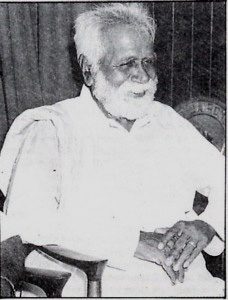
S. Ramanathan
Dr. S. Ramanathan offers us a refreshing change and sings Bharati’s muruga in the original tune (Natakurinji). The song was first published in 1922 as part of Bharati’s Sudesa Geetangal. Note Ramanathan’s clever usage of s” n d n p in his kalpana swaras. This phrase ties up with d n s” (muruga) in the first line of the composition.
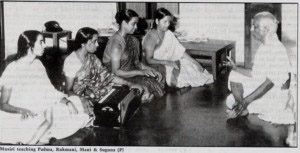
Musiri Subramania Iyer teaching
at the Music College, Madras
Of Tyagaraja’s two kritis in the raga, the one that is often heard is manasu vishaya. M. D. Ramanathan presents it in his characteristic style. M. Chandrasekharan plays the violin and Vellore Ramabhadran, the mridangam in this recording. MDR takes up the phrase sri tyagaraja for elaboration by neraval.
D. K. Pattammal sings Muthuswamy Dikshitar‘s sivakami patim.
Muthuswamy Dikshitar‘s (navagraha kriti) budhamashrayami is arguably the most popular kriti in Natakurinji. Semmangudi Srinivasa Iyer presents this kriti in the following set of clips. Lalgudi Jayaraman and Tiruchi Sankaran accompany him in this recording, excerpted from a live concert. First, we hear Semmangudi’s alapana.

Rudrapatnam Brothers
Illustrating our observation that Natakurinji is especially well suited for elaboration by tanam, Semmangudi and Lalgudi preface the navagraha kriti with a tanam.

Subramania
Bharati
The kriti budhamashrayami follows.
K. V. Narayanaswamy was another singer who used to revel in Natakurinji. His renditions of Swati Tirunal‘s (navaratri) kriti pahi janani were particularly memorable. The following recording is from a concert featured in the arangisai program in AIR (Madras). V. V. Subramanian plays the violin. First, an excerpt from KVN’s alapana.
KVN’s rendition of pahi janani follows. Note how KVN makes the transition from vilamba kala neraval to madhyama kala to kalpana swaras devoid of theatrics. Palghat Raghu provides brilliant accompaniment on the mridangam.
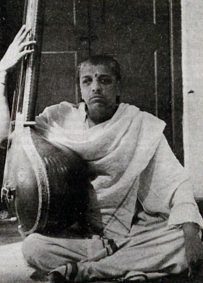
M. D. Ramanathan
In this final section, we present excerpts from a few recordings of Natakurinji in ragam, tanam and pallavi (RTP). The first set of clips in this section features S. Ramanathan, in a concert at the Music Academy, Madras (1980). The accompanists are Radha Narayanan and Madurai Srinivasan. S. Ramanathan’s initial sketch of the raga.
An excerpt of the tanam.
The pallavi kuvalaya dala nayana set to adi tala (2 kalai) is adapted from Tyagaraja’s kriti in Natakurinji.
M. L.Vasantakumari sings at the Music Academy (1960). The accompanists are Tiruvallur Subramaniam (violin) and Tanjavur Krishnamurthy Rao (mridangam). First, an excerpt from MLV’s alapana (note the application of d about 2:09 into the clip).
The tanam.
Followed by the pallavi tenparangiri valar muruga (khanda triputa – 4 kalai).
The next set of excerpts is from an RTP presented by R. N. Thyagarajan and R. N. Tharanathan (Rudrapatnam Brothers). The recording is from a live concert at Rutgers University (1991). Mysore Nagaraj plays the violin and V. Praveen accompanies on the mridangam.
Excerpts from the tanam.
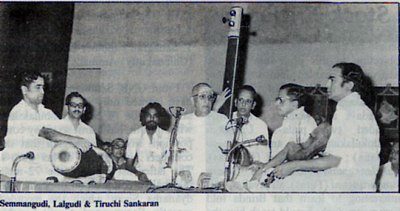
Semmangudi Srinivasa Iyer, Lalgudi Jayaraman and Tiruchi Sankaran
The traditional pallavi ciranta engalatu nattai kurinji enbar in adi (2 kalai) was featured in one of our earlier articles [9]. The Brothers sing this pallavi.
The final set of clips features G. N. Balasubramaniam, accompanied by M. S. Gopalakrishnan and Ramanathapuram C. S. Murugabhoopati. This is an excerpt from a live concert at Shanmukhananda Sabha, Bombay and is one of the few concerts of the master where his accompanists include a morsing player. Unfortunately the name of the accompanist is not recorded. The complete recording runs well over an hour and is one of the best pieces of recorded Indian music. We are constrained to present a drastically edited version and pick up proceedings in the middle of the alapana. Note GNB’s experimentation with p (about 2:30 into the clip).

M. L. Vasantakumari
Rasikas of a by-gone era are fond of describing GNB’s closing movements of an alapana as poopandal kattarathu (providing the finish touches to a magnificent pandal with a garland of flowers).
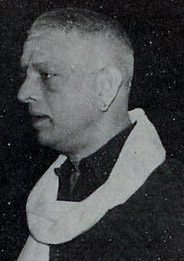
G. N. Balasubramaniam
An excerpt from the tanam.
The pallavi koniyada tarama nee mahima is set to Adi tala (tisra nadai). Though set in tisra nadai, the syllables of the pallavi are structured as 4+2+4 (before the aruti) and 2+4 (after). This preponderance of chatusra (fours) in the tisra (three) nadai creates a subtle tension. Murugabhoopati‘s accompaniment is unobtrusive, yet enriching.
Acknowledgements
The photographs in this feature appeared in various issues of the magazine, Sruti. It is a pleasure to thank Rajan P. Parrikar, Jaya and S. Pasupathy, and Sumitra Ranganathan for several discussions. We thank Rajan P. Parrikar, Jaya Pasupathy and Anita Thakur for their assistance in putting this feature together.
Authors’ note: We receive several requests for recordings but are unable to fulfill these. We request that readers not ask us for copies of recordings.
References
[1] S. R. Janakiraman, Raga Lakshanangal (Madras: Sangeeta Vidwat Sabha, 1995).
[2] See Harikambodi.
[3] https://raja1630.tripod.com/mktb/id1.html
See also: https://www.sangeetham.com/papsMay15.htm,
and: https://www.sangeetham.com/mkthyagaraja_bhagavatar.htm
[4] Subbarama Dikshitar, Sangita Sampradaya Pradarsini (Madras: The Music Academy, 1977).
[5] A tribute to Papanasam Sivan. It is interesting to note that the same theme, viz., dance, underpins Sivan’s kriti in Natakurinji, natana sabhapatiye arivan, uyar natana kalaiyin perumai (lit. only the Lord of Dance realizes the greatness of Dance).
[6] S. R. Janakiraman, Raga Lakshanangal.
[7] A profile of Higgins can be found in: https://www.indiangyan.com/clinton/arts_festivals.htm
This also includes an account of an anecdote that has some traces of the incident motivating the kriti in Nandan Caritam.
[8] For more on Bharati‘s musical interests, abilities and activities, see Cheeni Vishwanathan, Bharatiyum sangeetamum (Madras: Cheeni Vishwanathan, 1999). A small incident illustrating Bharati’s catholicism and innovativeness in music is recounted in: https://www.geocities.com/CollegePark/5409/adapt.html
